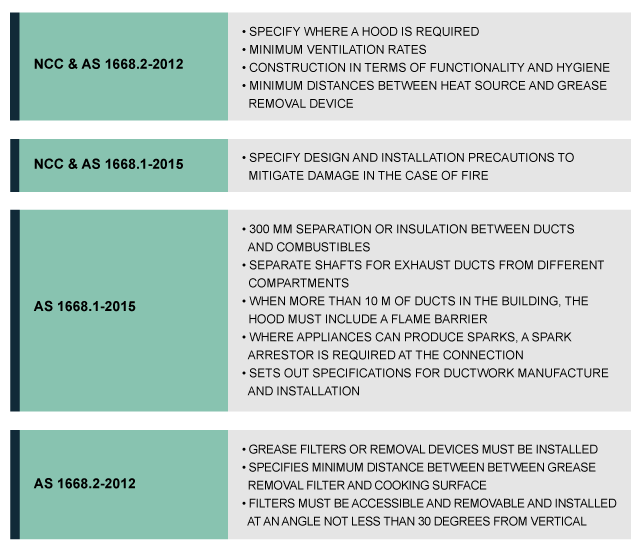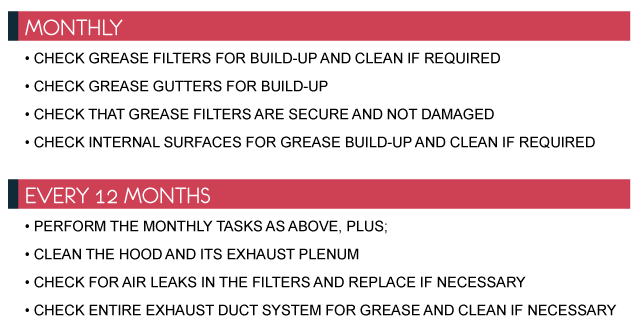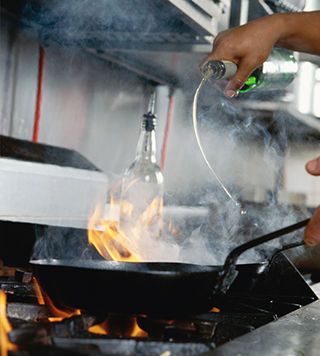In last week’s blog we looked at the kitchen fire hazard posed by commercial kitchen exhaust systems and how the three elements of grease, cooking and air can interact to produce a serious fire. This week we look at ways how to reduce the risk of fire and how to move towards best practice fire safety in your kitchen.
Meet the latest fire safety standards
Ensuring your kitchen hood exhaust system meets Australian Standards is a fundamental component of your fire safety strategy. Under the National Construction Code (NCC V1 2016), commercial kitchens must be provided with kitchen exhaust hoods in compliance with AS 1668.1-2015 and AS 1668.2-2012. And, for a hood to comply with AS 1668.1, the entire exhaust system must comply.
But what does compliance with these standards mean? The diagram below sets out the relevant fire safety standards and what they refer to in terms of compliance.

Fire safety standards and what they refer to in terms of compliance.
Familiarising yourself with the relevant standards is a good way to ensure your exhaust system meets minimum fire safety requirements. Visit Standards Australia for up-to-date information about all current Australian Standards.
Keep up your kitchen inspection & maintenance schedule
Meeting your kitchen inspection and maintenance obligations is critical to your fire safety regime, and this includes manufacturer inspections, which are often more stringent and regular than those in the Standards or legislation.
AS 1851-2012 sets out the minimum inspection, maintenance and record-keeping requirements for fire and smoke control features of kitchen exhaust systems and any associated sprinkler systems. If these minimum requirements have not been met and a fire breaks out, an owner/operator can be held liable by law.
Other inspection and maintenance regimes include state legislation in relation to buildings that house a commercial kitchen and Work Health & Safety (WHS) regulations and food safety standards.
Fundamentally, complying with the legislation and maintaining a clean, safe kitchen exhaust system is one of the most effective ways to mitigate your fire risk. The bare minimum of what should be included in your maintenance schedule is set out below.

Minimum requirements for kitchen exhaust maintenance
Beyond the minimum standards
While compliance with the standards reduces your fire risk significantly, taking a best practice approach means tailoring the cleaning, maintenance and inspection schedule to your specific kitchen. Ask yourself, what kind of cooking processes are used most in my kitchen? For how many hours is the kitchen exhaust system in use? The answers will determine your best practice fire safety regime.
For heavy kitchen usage (12 to 16 hours/day) a three-monthly inspection is recommended; for moderate usage (6 to 12 hours/day), six-monthly inspections; and for light use (2 to 6 hours/day), a yearly inspection might be adequate.
Cleaning should take place as often as necessary, monitoring your grease build-up with a depth gauge/grease comb. When grease depth is identified as exceeding 2mm, it’s time to clean your exhaust system. For more details on best practice cleaning methods for kitchen exhaust systems, read our blog on the topic.
Better safe than sorry
In Australia, kitchen fires are the source of 25% of all structural fires and of up to 50% of those that occur in commercial buildings. Of these fires, unattended cooking is the number one cause, more often than not occurring in the vicinity of the kitchen exhaust hood.
The multiple horror stories about what can happen when a build-up of grease meets an open flame should be motivation enough to aim for best practice fire safety. And keeping your exhaust system clean, safe and functioning properly is the most effective way to achieve this.

